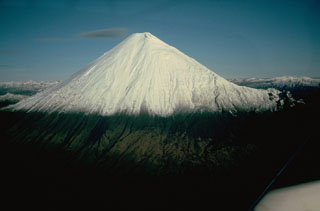Report on Sangay (Ecuador) — 22 November-28 November 2023
Smithsonian Institution / US Geological Survey
Weekly Volcanic Activity Report, 22 November-28 November 2023
Managing Editor: Sally Sennert.
Please cite this report as:
Global Volcanism Program, 2023. Report on Sangay (Ecuador) (Sennert, S, ed.). Weekly Volcanic Activity Report, 22 November-28 November 2023. Smithsonian Institution and US Geological Survey.
Sangay
Ecuador
2.005°S, 78.341°W; summit elev. 5286 m
All times are local (unless otherwise noted)
IG-EPN reported a high level of eruptive activity at Sangay during 21-28 November, with seismic stations recording 232-463 daily explosions. Ash-and-gas plumes visible in webcam and satellite images during 21, 23, and 27-28 November rose as high as 2 km above the crater rim and drifted N, NE, SE, and SW. Webcam images showed incandescent material at the summit vent and descending the SE flank as far as 1.8 km from the crater during 21-22 November. Weather clouds prevented observations during the rest of the week. Secretaría de Gestión de Riesgos maintained the Alert Level at Yellow (the second highest level on a four-color scale).
Geological Summary. The isolated Sangay volcano, located east of the Andean crest, is the southernmost of Ecuador's volcanoes and its most active. The steep-sided, glacier-covered, dominantly andesitic volcano grew within the open calderas of two previous edifices which were destroyed by collapse to the east, producing large debris avalanches that reached the Amazonian lowlands. The modern edifice dates back to at least 14,000 years ago. It towers above the tropical jungle on the east side; on the other sides flat plains of ash have been eroded by heavy rains into steep-walled canyons up to 600 m deep. The earliest report of an eruption was in 1628. Almost continuous eruptions were reported from 1728 until 1916, and again from 1934 to the present. The almost constant activity has caused frequent changes to the morphology of the summit crater complex.
Sources: Instituto Geofísico-Escuela Politécnica Nacional (IG-EPN), Servicio Nacional de Gestión de Riesgos y Emergencias (SNGRE)

